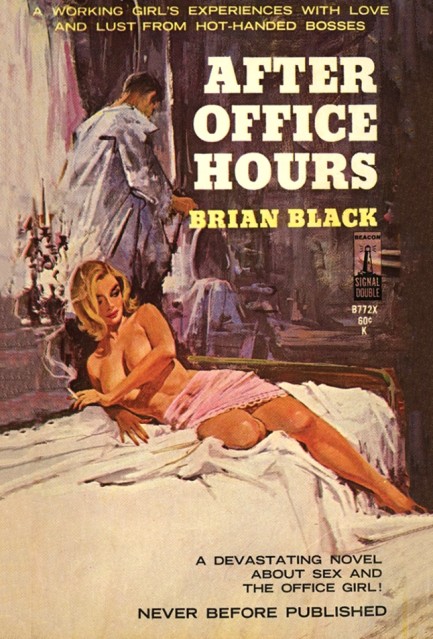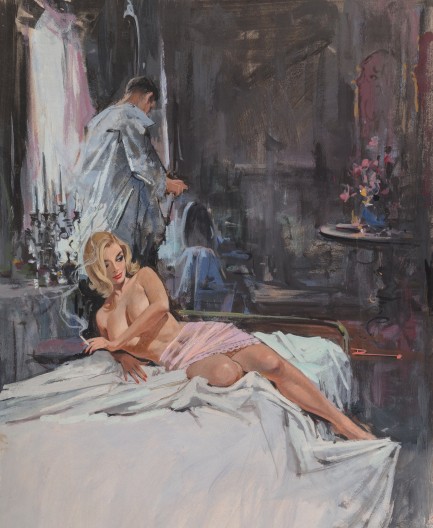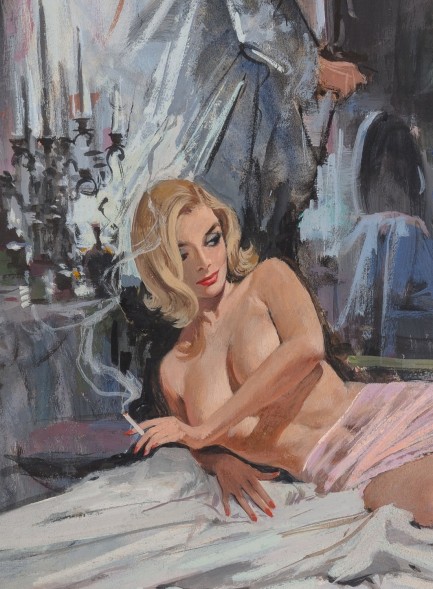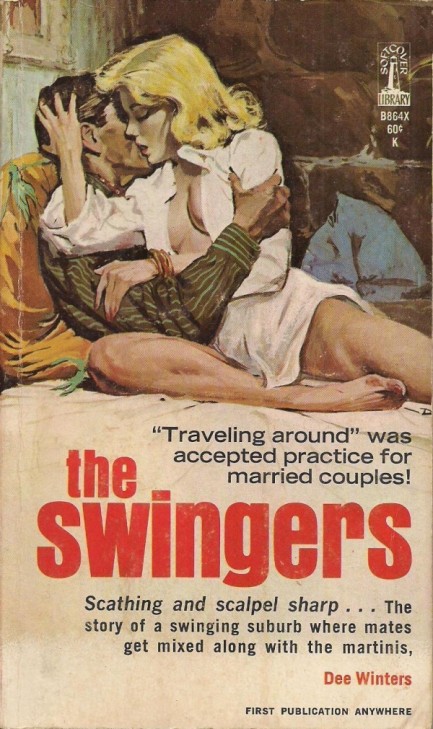 Hi there, convict. How'd ya like to perform a cavity search for a change?  
We've been eyeing a Russell Trainer novel called His Daughter's Friend for a while. It has one of illustrator Paul Rader's best covers. But since it's a pretty empty feeling to buy a book with a nice cover that turns out to be terribly written (often the case with sleaze novels), we wanted to sample Trainer's prose. With the price of His Daughter's Friend running as high as $200.00, a trial run was needed on cheaper books. Incidentally, we'd never pay that for a book anyway, but if Trainer can write, we'd probably go as high as $30.00, if we ever found a copy at that price. We ended up buying two Trainers, both at around fifteen bucks. You see the first above—Jail Bait. It's an Australian edition published by New Century Press without a copyright date or cover artist attribution. Originally it appeared in the U.S. and Canada in 1962 as The Warden's Wife.
That title pretty much sums up the idea behind the book, as a felon named Eddie Koski, after three years in max, is made a trustee and given a form of freedom as he works around the prison for the warden and other high ranking corrections officials. Unfortunately, the warden's smoking hot wife Thelma is keenly interested in working Eddie's shlong, which, of course, can only lead to trouble, if not more jail time. Things become doubly complicated when Eddie falls for a beautiful sociologist who comes to the prison to work on a dissertation. Can he escape the clutches of the dangerous Thelma and find love and freedom? Perhaps. The book is fun for the most part, but we'd have preferred the story to conclude without its late turn toward vicious homophobia. We weren't surprised when it happened, though. Consider yourselves forewarned.
Overall, we wouldn't say Jail Bait is either great or awful, which means Trainer probably will fail to add value to His Daugher's Friend. While we often buy books entirely for the cover art, we never buy expensive ones for that reason. What we love is a book that surpasses our expectations, like, for example, Val Munroe's surprisingly good 1952 sleazer Carnival of Passion. We suppose requiring decent writing skill with the cover art makes us amateurs at the book collecting game, but we're not really collectors anyway. We'll never sell them, in all likelihood. Nearly all the buyers would be in the U.S., and mailing them overseas, even at a profit, is too much work to even contemplate. So we'll give up our quest for His Daughter's Friend unless Trainer knocks book two—1963's No Way Back—completely out of the park. We'll read it in a bit and see where matters stand. 
 Stray, little birds! Stray and be free! 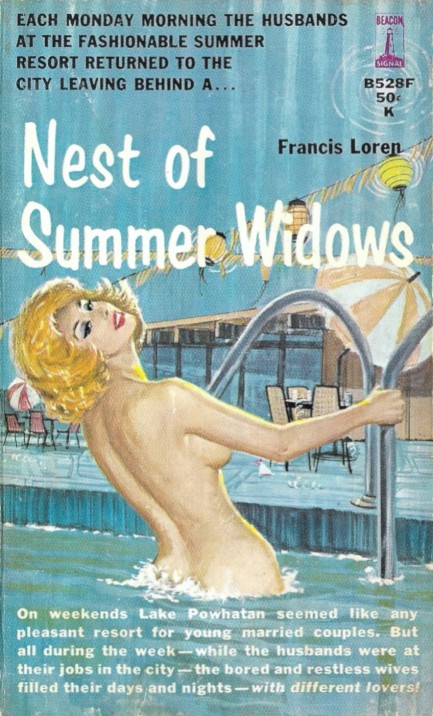
With a title like Nest of Summer Widows we absolutely had to read this 1962 effort from sleaze author Francis Loren, with its cool (uncredited) cover art, but guess what? There's no nest of widows. We took that to mean many widows. But there's only Ellen and Carla. The story is mainly about Ellen, whose husband spends each week away while she summers at Lake Powhatan. Let's stop for a sec. See, kids, “summering” is this thing people did—way before our time too, but we've read about it and seen it depicted in movies like The Seven Year Itch—where people left big cities for lake or beach regions and spent the hot months hanging around in swimsuits.
Ellen's husband is a lawyer, but isn't rich, which is the only measure of success she knows. She figures he doesn't lawyer hard enough. Since he comes to the lake only on the weekends, Ellen has plenty of idle time to get oopsied into bed by rich lake resident Tony Marsh. When Marsh later offers Ellen's hubby a lucrative job, lawyer boy hesitates because he thinks Marsh is a phony. The story finds Ellen torn between her husband and her sidepiece. Personally, we question a lawyer who's smart enough to pass the bar but not smart enough to know a rival's been dropping caseloads in his wife's inbox, but whatever.
We found a few aspects of the book interesting, but the chief curiosity is how most of what happens is a direct result of alcohol consumption, including the job offer. Those lake summerers really drank (scotch-sours and martinis, mainly). We guess the idle time made a body thirsty? It's a question we'd like to answer through firsthand experience one day. Cue the Pulp Intl. girlfriends: “You guys are thirsty 24/7. Why wouldn't you be thirsty idle?” It seems a fair point until you read the level of boozing in this book. But since they mention it— *off to the kitchen to build a quick cocktail*
Back now. And by the way, kids, that was a pro move, relationship-wise. Whenever your girl, wife, partner, mentions that you drink a lot, make a drink. It's a drinking game they won't know they're playing at first. It works best if you're flawless in every other aspect of your relationship. Hah—we only write stuff like that so they'll read it and roll their eyes at us. But returning to the book, Loren asks several questions that need resolution. What does a person do when their head says one thing but their sex organs say another? Is Ellen's husband a loser? Is Marsh a phony? Will summer ever end? Oh what tangled sleaze Loren weaves. 
 I'm baffled, frankly. When I chose women as my area of specialization I didn't realize how hard it would be to figure out what's bothering all of you. 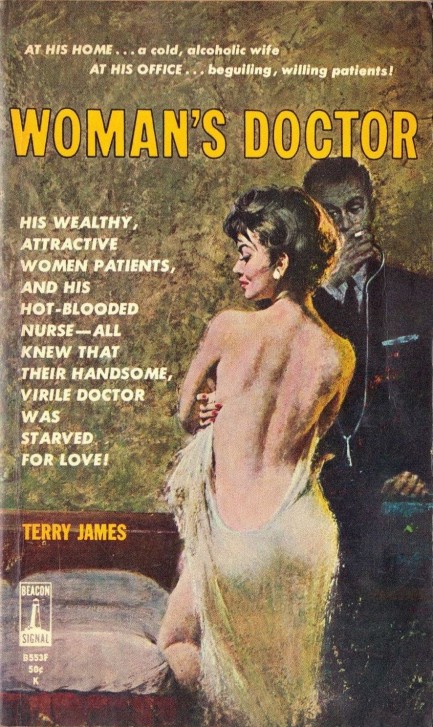
Above: a little Beacon Signal sleaze for you today, a cover for Woman's Doctor by Terry James, published in 1962. We've shared numerous medical paperback covers over the years. Several of our favorites are here, here, here, and here.
 You know, you have marvelous muscle tone for a woman eleven feet tall. 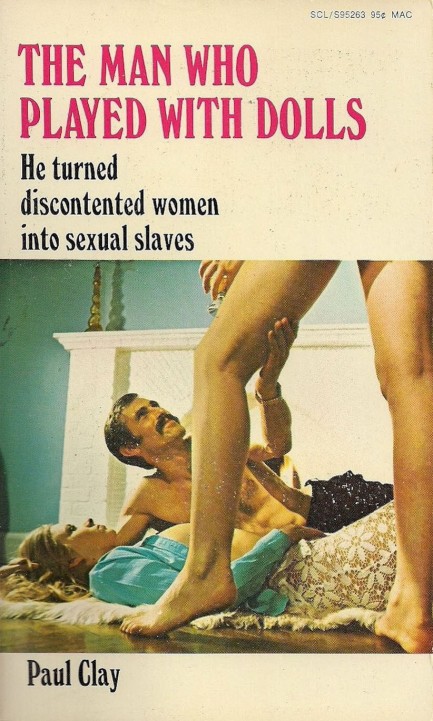
Above: a photo cover for the 1967 sleazer The Man Who Played with Dolls, written by Paul Clay for Softcover Library. “He turned discontented women into sexual slaves.” The Pulp Intl. girlfriends really got a kick out of that. Softcover, which evolved from Beacon Signal, provided the world with some pretty nice book fronts, including here, here, and here, but by this time was moving away from paintings to photos like all the publishers. What it didn't move away from was sleaze, its bread and butter, more of which we'll show you down the line, assuming we can ever stop looking at this one, with Dennis Weaver* copping a cheap feel. Hands off the merch, McCloud. *Probably not really Dennis Weaver.
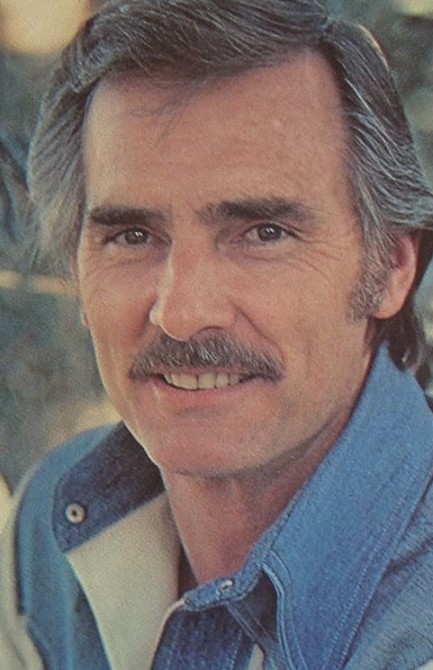
 I'm sorry to say it, but this has to end. I mean for today. I'll see you here tomorrow same time. 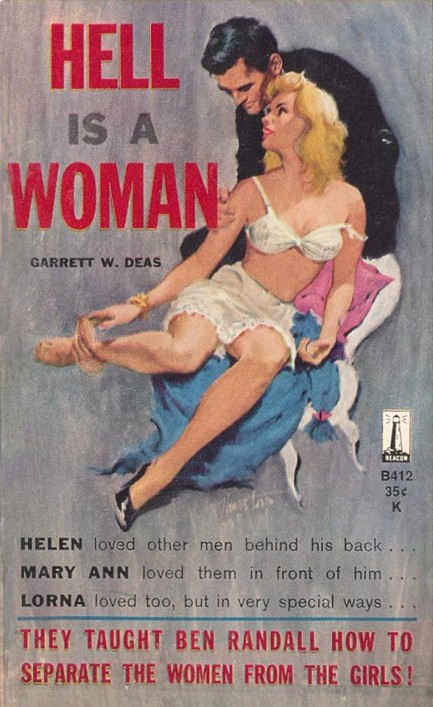
Does Hell Is a Woman look like a crime novel to you? Us either, but it is. Beacon Books decided to market this effort from Garrett W. Deas as sleaze, and used cover art from Jack Thurston to implant the idea into book rack browsers' heads. Beacon also wrote cover text in that vein, though it's wildly inaccurate. Protagonist Sheriff Ben Randall's wife Helen loved other men behind his back? Not true. She has an affair with one man. Mary Ann, according to the cover, loved other men in front of Ben? Not true. She starts the novel as a corpse. Lorna loved in very special ways? Maybe. She pines for the sheriff and ignores other men. Also, Helen's cheating is meant by Deas to be a suspicion followed by a revelation. Beacon spoiled that. You take your chances with cover blurbs. But all that aside, as a crime novel Hell Is a Woman is pretty good, with a rural setting that works, and Sheriff Ben as a likeable sort who doggedly tries to solve three murders while the county bigwigs want everything swept under the rug. The main flaw of the book is that the identity of the killer becomes obvious well before we think Deas means it to, but overall he did decent work. It seems to have been his only novel, though, which is too bad.

 Okay, I think we're ready. Formula for edible pomegranate flavored body oil, test seventeen, commencing now. 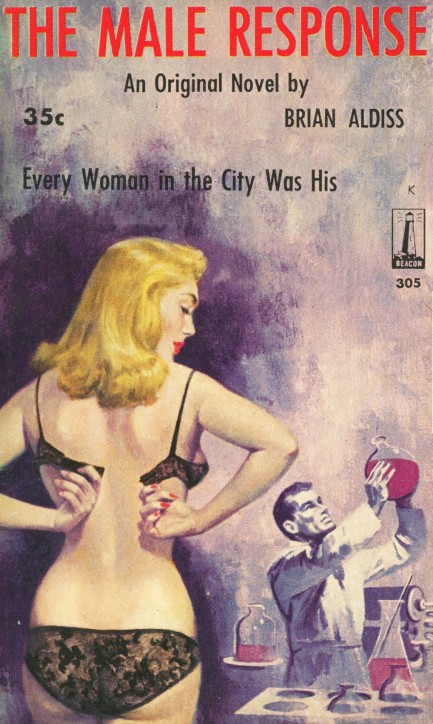
Brian Aldiss was better known as a sci-fi author, but his 1961 novel The Male Response deals with sexual mores and politics. On Aldiss's website he writes: “Only marginally science fiction, the story tells how the indecisive Soames Noyes is sent by his company with a computer to the newly free black state of Goya, in Africa, where he becomes entangled with women and witch-doctors. Reluctantly, Noyes faces all challenges and, following by public promiscuity, becomes President.” That certainly sounds fun, especially the promiscuity to president part. It obviously could only happen in sci-fi. The cover art here is by Robert Stanley.
 You can love her but you can never trust her. 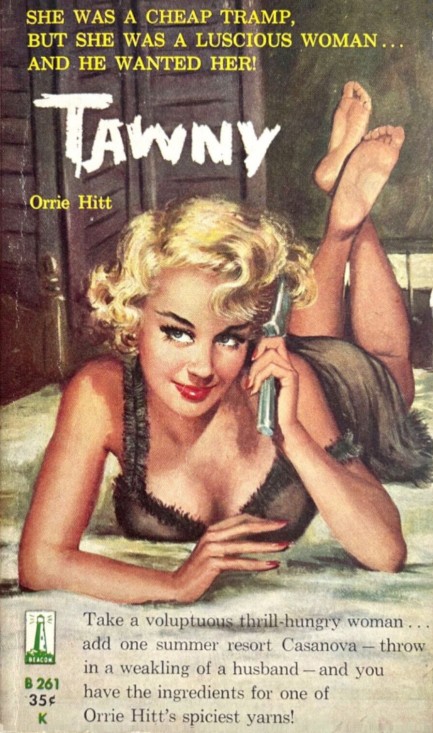
A while back we said we'd skip the 1954 Orrie Hitt novel Cabin Fever because we had several other Hitt books awaiting our attention. But the cover art for 1959's Tawny enticed us, so we bought it and—turns out we didn't pass on Cabin Fever after all, because Tawny is Cabin Fever published under a new name. It was also published yet again in 1974 as Lovers at Night. Lesson: watch out for re-titles in vintage literature. But it's okay. Hitt is interesting if erratic, and since this is an early effort from him—possibly only his third, though we can't be sure because he published four books in 1954—we were curious to have a look.
Tawny follows the travails of Danny O'Conner, who takes a job managing a sprawling lakeside roadhouse/casino/cabin complex called the Flying Red Rooster and quickly becomes romatically entangled with the boss's omnivorous wife, the eponymous Tawny Stone. She hates her husband but divorcing him would mean losing her stake in the business she originally financed. You'd think this would lead to the usual murder-the-husband scheme, but Hitt twists the plot the other direction when the husband approaches Danny and says that he wants Tawny to die or disappear.
So the question is who tries to kill who? Or maybe they both take a whack at homicide. We ain't saying. In the end, though, you still have juicy adultery and a sinister murder plot. We've read a lot of books along those lines, often by better writers, but we've read them by worse writers too. In the hands of a top stylist Tawny might have been a real barnburner. As it is, we can call it readable but not special. The art on this Beacon Signal edition (it was also published by Softcover Library in 1969) is by an unknown, which is too bad because it's one of the better covers on a Hitt novel. The far less tawny original painting appears below.
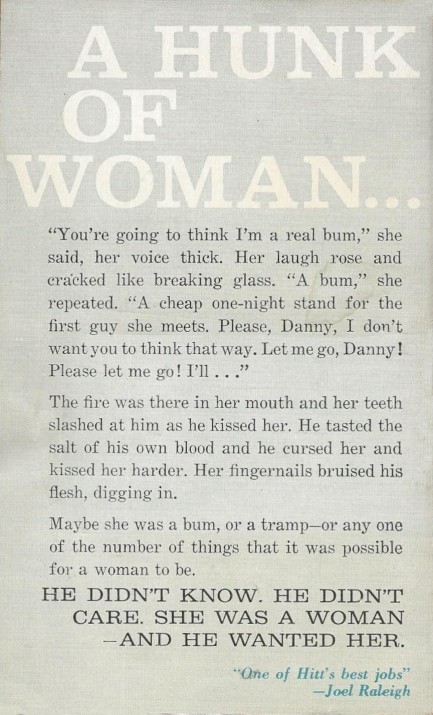 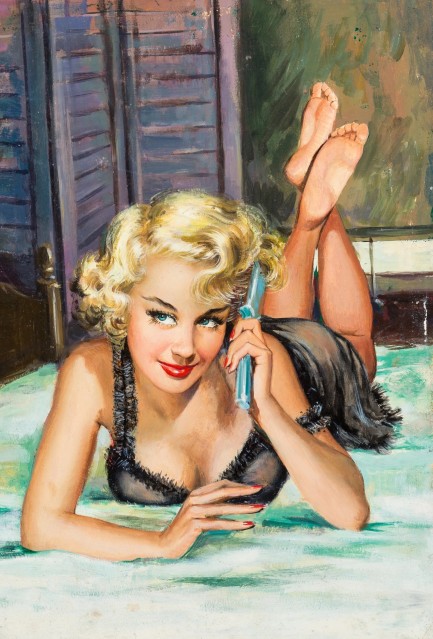
 I wouldn't call them raging so much as extremely reluctant to take no for an answer. 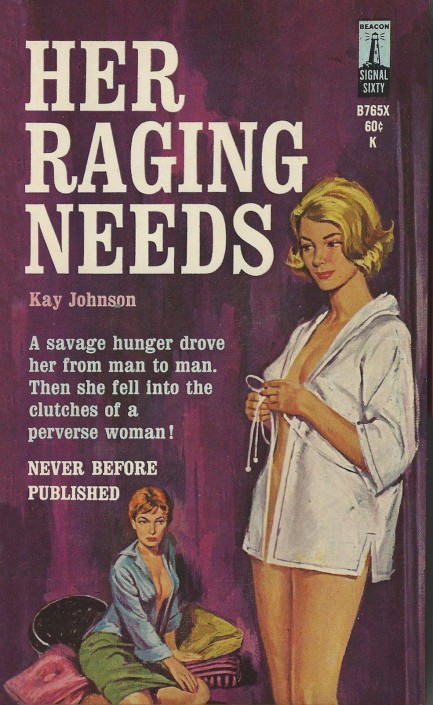
A little bit of vintage lesbian fiction today, Her Raging Needs, by Kay Johnson for Beacon Signal, 1964, with uncredited cover art. A libidinous young woman finds herself widowed, after which point she goes from to man to man, never satiated, until she finally crosses the line and jumps into bed with another woman. This one deserves points for the main character's name: Honey Bard. Amazingly, the book got reprinted in 1970 by Softcover Library.
 Is sex déjà-vu a thing? Because I feel like we've lived this before. Try not to finish so fast this time. 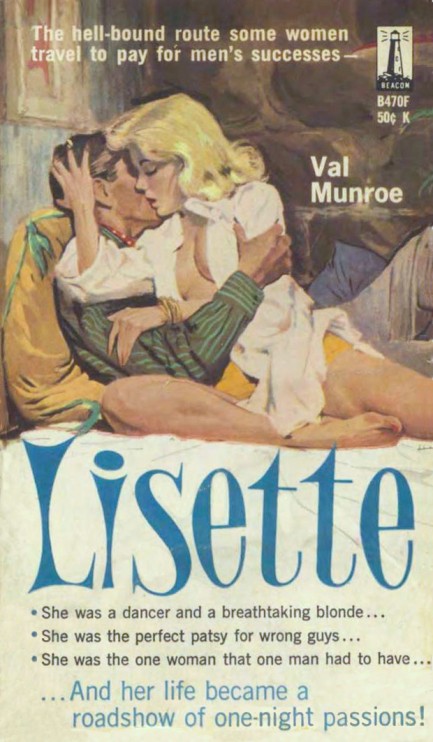
Above: a cover for Val Munroe's Lisette, painted by Darcy, aka Ernest Chiriacka for Beacon Signal, 1962. We were surprised when we discovered this was Munroe's Carnival of Passion under a different title. Since the name of the main character is Lisette rather than Liz, we didn't guess it was the same book, and you'll also notice the cover doesn't mention a carnival. Luckily we didn't pay for this because it was available for download on Archive.org. By the way, the story wasn't the only thing repeated here. The art was later paired with Dee Winters' 1965 sleazer The Swingers, as you see below.

|
 |

The headlines that mattered yesteryear.
2003—Hope Dies
Film legend Bob Hope dies of pneumonia two months after celebrating his 100th birthday. 1945—Churchill Given the Sack
In spite of admiring Winston Churchill as a great wartime leader, Britons elect
Clement Attlee the nation's new prime minister in a sweeping victory for the Labour Party over the Conservatives. 1952—Evita Peron Dies
Eva Duarte de Peron, aka Evita, wife of the president of the Argentine Republic, dies from cancer at age 33. Evita had brought the working classes into a position of political power never witnessed before, but was hated by the nation's powerful military class. She is lain to rest in Milan, Italy in a secret grave under a nun's name, but is eventually returned to Argentina for reburial beside her husband in 1974. 1943—Mussolini Calls It Quits
Italian dictator Benito Mussolini steps down as head of the armed forces and the government. It soon becomes clear that Il Duce did not relinquish power voluntarily, but was forced to resign after former Fascist colleagues turned against him. He is later installed by Germany as leader of the Italian Social Republic in the north of the country, but is killed by partisans in 1945.
|

|
|

It's easy. We have an uploader that makes it a snap. Use it to submit your art, text, header, and subhead. Your post can be funny, serious, or anything in between, as long as it's vintage pulp. You'll get a byline and experience the fleeting pride of free authorship. We'll edit your post for typos, but the rest is up to you. Click here to give us your best shot.

|
|








